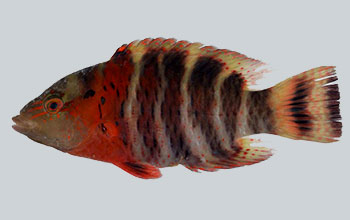Multimedia Gallery
Cheilinus fasciatus, or red-breasted wrasse, on coral reef in Palau
A Cheilinus fasciatus, or red-breasted wrasse, on a coral reef in Palau. A recent study found that the sensory system in fish fins evolves in parallel to fin shape and mechanics, and is specifically tuned to work with the fish's swimming behavior.
More about this image
A study by researchers at the University of Chicago has found that the sensory system in fish fins evolves in parallel to fin shape and mechanics, and is specifically tuned to work with the fish's swimming behavior. The researchers found these parallels across a wide range of fish species, suggesting that it may occur in other animals as well.
For the study, researchers combined measurements of fin shape from hundreds of specimens of the Labridae family with fin mechanical properties and neural responses recorded from eight different Labrid species, commonly known as wrasses. These measurements were then mapped on an evolutionary tree of 340 wrasses to determine how the mechanical properties and nervous systems of the fins evolved over time.
"As pectoral fins evolve different shapes, behaviors, and mechanical properties, we've shown that the sensory system is also evolving with them," said Brett Aiello, a Ph.D. student in the Department of Organismal Biology and Anatomy, and lead author of the study. "This allows the sensory system to be tuned to the different stimuli relevant to the locomotor behaviors and fin mechanics of different species."
Besides giving biologists a better understanding of how fish have optimized their swimming mechanics, the results of the study could also be useful to engineers developing underwater autonomous vehicles. The propulsion systems of these devices need to be both efficient and responsive, and there are perhaps no better designs to copy than those perfected through evolution over millions of years.
[This research was supported in part by the National Science Foundation (grants DGE 0903637, IOS 1425049, DEB 1541547 and IOS 1257886).]
To learn more, see the University of Chicago news story As fins evolve to help fish swim, so does the nervous system. (Date image taken: April 2017; date originally posted to NSF Multimedia Gallery: March 3, 2018)
Credit: Mark Westneat, University of Chicago
Images and other media in the National Science Foundation Multimedia Gallery are available for use in print and electronic material by NSF employees, members of the media, university staff, teachers and the general public. All media in the gallery are intended for personal, educational and nonprofit/non-commercial use only.
Images credited to the National Science Foundation, a federal agency, are in the public domain. The images were created by employees of the United States Government as part of their official duties or prepared by contractors as "works for hire" for NSF. You may freely use NSF-credited images and, at your discretion, credit NSF with a "Courtesy: National Science Foundation" notation.
Additional information about general usage can be found in Conditions.
Also Available:
Download the high-resolution JPG version of the image. (257.2 KB)
Use your mouse to right-click (Mac users may need to Ctrl-click) the link above and choose the option that will save the file or target to your computer.

 All images in this series
All images in this series